How to Grow Pineapples: Your Step-by-Step Home Guide
- March 13, 2024
- 0 comment
Pineapples, with their unique structure and sweet, tangy flavor, are a favorite among fruit enthusiasts. Growing pineapples at home may seem challenging, given their tropical origin, but with the right knowledge, you can cultivate these delightful fruits in your own backyard or even indoors.

| Benefit | Explanation |
|---|---|
| High in Vitamins and Minerals | Pineapples are rich in Vitamin C, which is essential for immune function, and they also contain manganese, important for bone health and metabolism. |
| Contains Antioxidants | They are packed with antioxidants like flavonoids and phenolic acids, which help fight oxidative stress. |
| Aids in Digestion | Bromelain, an enzyme found in pineapples, can aid in breaking down proteins, thus assisting in digestion. |
| Anti-Inflammatory Properties | Bromelain also has anti-inflammatory properties, which can be beneficial in reducing symptoms of arthritis and may aid recovery after surgery or strenuous exercise. |
| May Boost Immunity | The high Vitamin C content, along with other antioxidants, supports the immune system, potentially reducing the incidence of infections like colds and flu. |
| Supports Recovery | Bromelain may reduce inflammation, swelling, bruising, and pain that often occurs after surgery. |
| May Improve Heart Health | The fiber and potassium in pineapples are good for heart health. Potassium can help manage blood pressure levels, and dietary fiber is associated with lower risk of heart disease. |
| Supports Eye Health | Pineapples contain beta-carotene and Vitamin C, which are beneficial for eye health and may reduce the risk of macular degeneration, a common cause of age-related vision loss. |
| Aids Weight Loss | Being low in calories and high in water content, pineapples can promote a feeling of fullness and may aid in weight loss efforts. |
| May Reduce Cancer Risk | Certain compounds in pineapples, such as bromelain and various antioxidants, have been studied for their potential anti-cancer properties, though more research is needed in this area. |
List on How To Grow Pineapples
- Choose the Right Pineapple
- Prep the Crown
- Root the Crown
- Soil and Potting
- Ideal Growing Conditions
- Watering
- Fertilizing
- Patience is Key
- Look for the Flower
- Harvesting Your Pineapple
Choose the Right Pineapple
The success of growing a pineapple plant begins with the selection of the fruit itself. The condition of the pineapple, especially its crown, plays a crucial role in the potential growth and health of the future plant.
Characteristics of a Healthy Pineapple

- Appearance: Look for a pineapple that has a vibrant, green crown. The leaves should be firm, not wilting or brown, indicating good health and vitality.
- Ripeness: The fruit should be ripe, which can be assessed by its color and feel. The skin should have a golden-yellow hue, and the body should yield slightly to gentle pressure. However, it shouldn’t be too soft or have dark, soft spots, as these are signs of overripeness or decay.
- Smell: A ripe pineapple emits a sweet, pleasant aroma at its base. An absence of fragrance often means the fruit is not ripe, whereas a sour or fermented smell indicates it’s overripe.
Why the Crown Matters
The crown of the pineapple is the part that will be planted. Its health is indicative of the potential growth rate and success of your pineapple plant. A green and vigorous crown is more likely to root successfully and grow into a healthy plant.
Prep the Crown
The success of growing a pineapple plant largely depends on how well you prepare the crown. Here’s a detailed look at each step:
Selecting the Crown
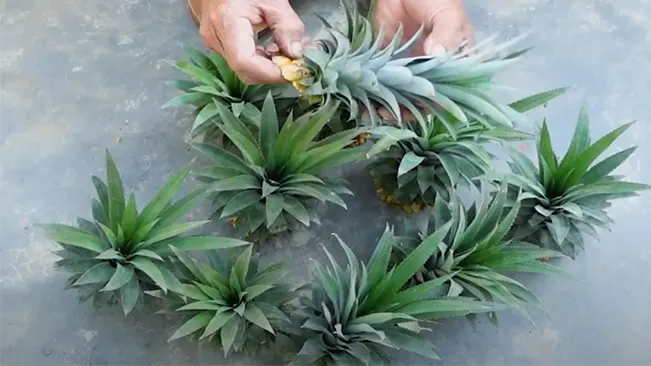
- Choose a crown that looks fresh and green. The leaves should be firm and not wilted. This indicates a healthy crown that is more likely to root successfully.
Detaching the Crown
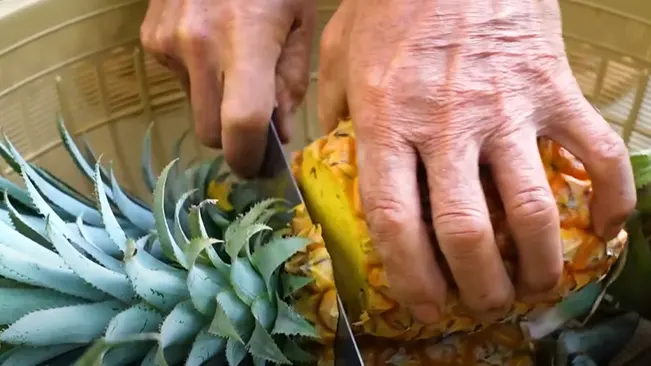
- There are two main methods to detach the crown from the fruit:
- Twisting Off: Hold the fruit firmly in one hand and the crown in the other. Gently but firmly twist the crown in a back-and-forth motion until it detaches from the fruit. This method is preferred as it tends to leave a cleaner stem and reduces the risk of damaging the crown.
- Cutting Off: If twisting is difficult, you can cut the crown off the top of the fruit. Use a sharp knife and leave a short piece of the fruit’s flesh attached to the crown. This method may require more cleaning and drying time to avoid rot.
Trimming the Crown
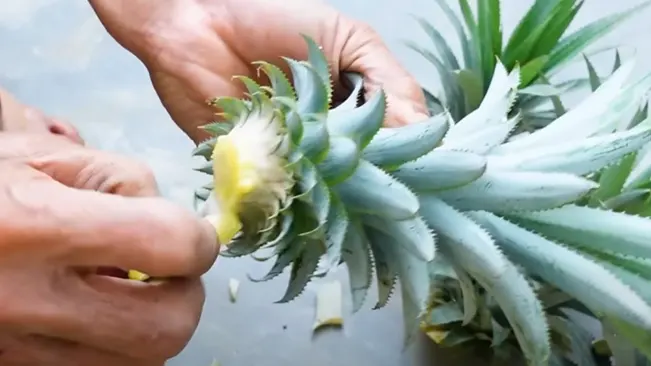
- After detaching the crown, remove some of the lowest leaves to expose about an inch (2-3 cm) of the base stem. This is the part that will root.
- Gently peel off the leaves rather than cutting them to minimize damage to the stem.
- Removing these leaves helps prevent rot and encourages roots to grow from the exposed stem area.
Drying the Crown
- Once you’ve exposed the base stem, allow the crown to dry for a few days before planting. This step is crucial.
- Drying helps to heal any cuts or bruises, reducing the risk of rotting when the crown is planted in soil or water. It forms a callous over the exposed areas, which is beneficial for root development.
- Place the crown in a well-ventilated area but avoid direct sunlight during this drying period. The spot should be warm but not hot.
Observing for Readiness
- The crown is ready for the next step – rooting in water or soil – when the cut end looks dry and slightly calloused.
- If you notice any signs of rot or excessive browning, trim off the affected area and allow it to dry for another day or two.
Root the Crown
Rooting the crown of a pineapple is the first crucial step in transforming a grocery store pineapple into a thriving plant. This process involves encouraging the pineapple crown to develop roots, preparing it for planting in soil.
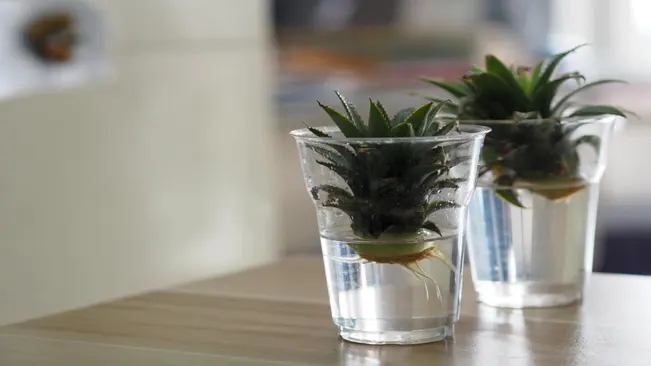
Step-by-Step Guide
- Preparing the Crown: After separating the crown from the fruit, it’s important to clean and prepare it for rooting. Strip off some of the lower leaves to expose the stem. This increases the surface area for root growth and helps prevent rotting.
- Drying the Crown: Before submerging the stem in water, let the crown air-dry for a few days. This drying period is crucial as it allows the cut end to heal slightly, reducing the risk of rot when placed in water.
- Water Submersion: Place the crown in a glass of clean water, ensuring that only the exposed stem is submerged. This positioning is crucial – if the leaves are underwater, they could rot.
- Choosing the Right Spot: The glass should be placed in a sunny, warm location. Light is essential for the crown to stay healthy and encourage root growth. However, avoid direct, intense sunlight that can scorch the leaves.
- Water Maintenance: It’s vital to change the water in the glass every few days to prevent bacterial growth and to provide fresh nutrients to the crown. Using lukewarm water is often recommended.
- Observing Root Growth: In about 2-3 weeks, you should start to see small roots emerging from the stem. These roots can vary in color from white to light brown. The appearance of roots indicates that the crown is ready to be planted in soil.
- Patience: Some crowns may take longer to root, and others might not root at all. It’s a natural process, and each crown behaves differently. Be patient and keep an eye on the progress.
Soil and Potting
Pineapple plants are not too finicky when it comes to soil, but they do have some specific needs to ensure healthy growth and eventual fruit production. Here are the key aspects to consider:

Soil Composition
- Loamy Soil: Pineapples thrive in loamy soil, which is a mix of sand, silt, and clay. This type of soil is ideal because it balances moisture retention and drainage.
- Slightly Acidic pH: Pineapples prefer a soil pH between 4.5 and 6.5. Slightly acidic conditions help the plant absorb nutrients more efficiently.
- Well-Draining Mix: Good drainage is crucial. A waterlogged soil can lead to root rot, which is detrimental to pineapple plants. Incorporating sand and perlite into the potting mix improves drainage.
Potting Mix Recipe
A recommended potting mix for pineapples would be:
- 60% high-quality potting soil
- 20% sand
- 20% perlite or vermiculite
This blend ensures the soil is loose enough for water to drain freely while retaining adequate nutrients and moisture for the plant’s roots.
Pot Selection
- Size: Choose a large pot, as pineapples have a root system that spreads out. A pot that is at least 12 inches deep and wide is a good start.
- Material: Terracotta or breathable fabric pots are great as they allow for better air circulation around the roots.
- Drainage Holes: Ensure the pot has sufficient drainage holes to prevent water accumulation at the bottom.
Planting the Crown
- Planting Depth: Plant the crown so the bare stem is buried, and the base of the leaves is just above the soil surface.
- Initial Watering: After planting, water the soil thoroughly. This helps settle the soil around the roots and removes air pockets.
Ideal Growing Conditions
Pineapples are indigenous to South America and thrive in a warm, tropical climate. This background is key to understanding their ideal growing conditions.

Sunlight Requirements
- Intensity and Duration: Pineapples need abundant sunlight, making them perfect for sunny climates. At least 6-8 hours of direct sunlight per day is essential for healthy growth and fruit development. The intensity of the sunlight directly influences the sweetness of the fruit.
- Placement: If you’re growing pineapples in pots, place them where they can receive uninterrupted sunlight, such as south-facing locations in the Northern Hemisphere. In outdoor gardens, ensure they are planted in the sunniest part of the garden.
Temperature Range
- Ideal Temperature: Pineapples flourish in temperatures ranging from 65°F to 85°F (18°C to 29°C). These temperatures encourage active growth and fruit development.
- Protecting from Cold: If temperatures drop below 60°F (15°C), pineapples can suffer. In cooler climates, it’s advisable to grow pineapples in pots so they can be moved indoors or to a warmer spot during colder periods.
- Heat Tolerance: While they are heat-loving, extremely high temperatures combined with direct sunlight can cause sunburn on the leaves. In areas with intensely hot summers, some afternoon shade or light filtering can be beneficial.
Humidity Requirements
- Tropical Humidity: Pineapples also prefer high humidity, typical of tropical environments. A relative humidity of 60% or higher is ideal.
- Misting: In drier climates, misting the plants can help increase humidity. However, ensure that the crown doesn’t hold water as this can lead to rot.
Wind Protection
- Sheltering from Wind: Strong winds can damage the leaves. If you live in a windy area, consider planting your pineapple in a sheltered spot or use windbreaks.
Acclimatization
- Gradual Introduction: If you start your pineapple indoors or in a greenhouse, it’s crucial to acclimatize it to outdoor conditions gradually. This process involves exposing the plant to outdoor temperatures and sunlight incrementally over a week or two.
Watering
Water the plant thoroughly, then allow the top inch of soil to dry out before watering again. Pineapples have shallow roots and are drought tolerant, so it’s important not to overwater.
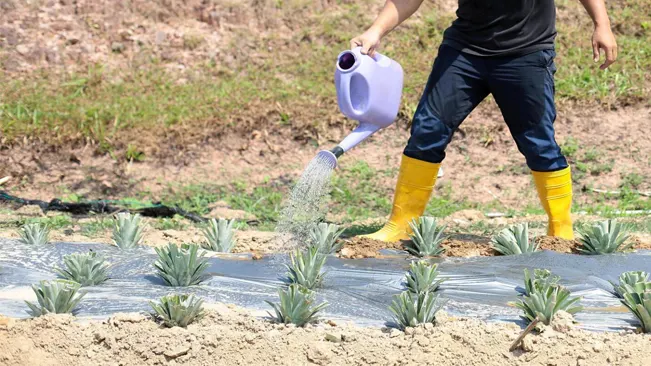
- Soil Moisture Balance: Pineapples prefer a soil that is moist but never soggy. The top inch of the soil should be allowed to dry out between waterings. This drying out period is crucial as it provides the roots with much-needed oxygen and prevents fungal infections.
- Frequency of Watering: The frequency of watering will depend largely on your climate and the time of year. In warmer, sunnier weather, you may need to water more frequently, whereas in cooler or overcast conditions, the soil will retain moisture longer and require less frequent watering.
- Checking Soil Moisture: Before watering, check the soil moisture. You can do this simply by inserting your finger into the soil. If the top inch feels dry, it’s time to water. If it still feels moist, wait a day or two and check again.
- Watering Technique: When you do water, do so thoroughly. This means watering the plant until you see water run out of the bottom of the pot, ensuring that the entire root system has been reached. However, make sure that your pot has adequate drainage to avoid waterlogging.
- Seasonal Adjustments: Be aware of seasonal changes in your plant’s watering needs. Pineapple plants will require less water in the winter months when they aren’t actively growing.
- Impact of Potting and Environment: The type of pot and the environment can also affect how quickly soil dries out. For example, clay pots allow soil to dry out faster than plastic pots. Indoor plants may require less frequent watering than those outdoors in direct sun.
Fertilizing
Pineapple plants, like all plants, require certain nutrients to grow healthily and produce fruit. Fertilizing is an essential part of caring for these plants, especially since they are often grown in pots where nutrients may be more limited compared to open ground.
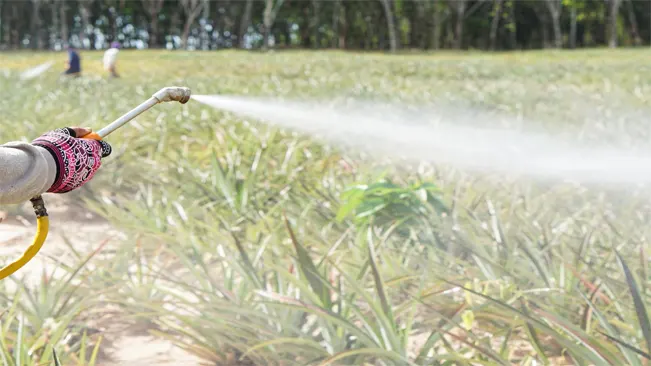
Types of Fertilizers
- Balanced, Water-Soluble Fertilizer: This is typically recommended for pineapple plants. A balanced fertilizer has equal parts of nitrogen, phosphorus, and potassium (often denoted as N-P-K on packaging). A formula such as 20-20-20 or 10-10-10 is suitable.
- Slow-Release Fertilizer: Alternatively, a slow-release granular fertilizer can be used. This type releases nutrients gradually over time, reducing the need for frequent applications.
When and How to Fertilize
- Growing Season: Pineapple plants should be fertilized approximately once a month during their active growing season, which is usually spring and summer. During these months, the plant is actively growing and preparing to fruit, so it requires more nutrients.
- Winter Months: In the winter, the plant’s growth slows down. Thus, you should reduce the frequency of fertilization. Over-fertilizing during this period can harm the plant, leading to nutrient burn or unwanted growth spurts.
- Application: When applying water-soluble fertilizer, dilute it as per the instructions on the package. Apply it to the soil, not directly onto the plant or its crown. For granular fertilizers, sprinkle the granules around the base of the plant and water thoroughly.
Nutrient Requirements
- Nitrogen (N): Essential for leaf growth. However, too much nitrogen can lead to lush foliage at the expense of fruit.
- Phosphorus (P): Important for root development and flowering. Phosphorus helps in the development of the pineapple fruit.
- Potassium (K): Helps in overall plant health and improves disease resistance. It also plays a role in fruit development.
Patience is Key
Pineapples, unlike many other fruit plants, have a relatively long growth and maturation cycle. This cycle can be broken down into several stages:
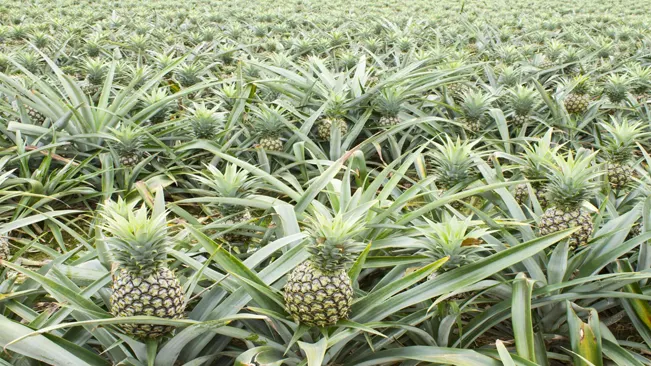
- Rooting Stage: After planting the crown, the initial few months are crucial as the plant develops roots. This stage doesn’t offer much visual progress, but it’s essential for the plant’s future growth.
- Vegetative Growth: Once roots are established, the pineapple plant begins to grow leaves and strengthen its base. This vegetative phase is where the plant focuses on developing a strong structure and can last for quite a while, usually more than a year.
- Flowering: Pineapple plants typically flower after 1-2 years, but this can vary depending on growing conditions. The flower, which later turns into the pineapple fruit, is a unique and striking sight. It starts as a reddish-purple bud and blooms over several days.
- Fruit Development: After flowering, the fruit begins to develop. This process is gradual; the fruit swells and matures over several months. The exact time from flowering to fruit maturity can vary based on climate, care, and the variety of the pineapple.
Why Patience is Essential
- Pineapple Growth is Natural and Unhurried: Unlike some fruits that can be hastened through various agricultural techniques, pineapples generally take their time. There’s no reliable way to significantly speed up their growth cycle without potentially harming the plant or the fruit quality.
- Stress on the Plant: Attempting to rush the process or being impatient can lead to unnecessary stress on the plant. For example, overwatering or overfertilizing in hopes of faster growth can lead to adverse effects.
- Observation and Care: This period of growth allows gardeners to observe and respond to the plant’s needs. It’s a learning process where one becomes attuned to the subtleties of caring for a tropical plant.
Look for the Flower
The Initiation of the Flower
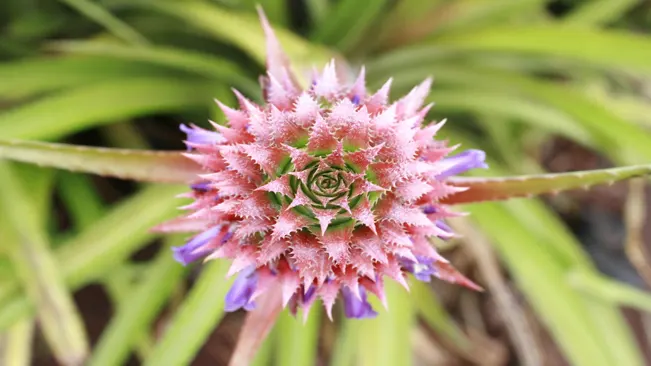
- The pineapple plant is a bromeliad, and its flowering marks the beginning of the fruit’s development. This process can take quite a long time, usually around 12-24 months after planting, depending on the growing conditions.
Appearance of the Flower
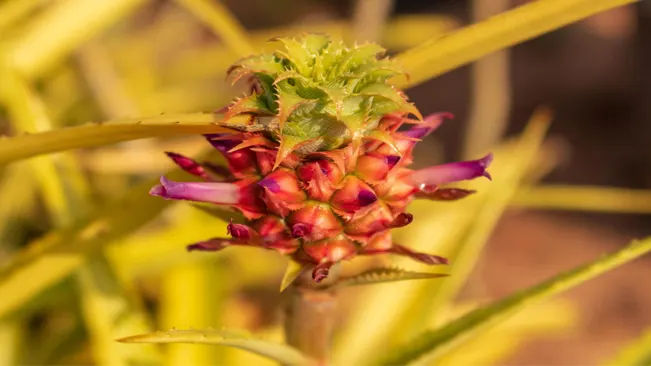
- When the plant is ready to flower, a spike emerges from the center of the rosette of leaves. This spike is the start of the pineapple flower. The flower bud initially appears as a reddish-purple spire, which is quite striking against the green foliage.
The Flower Structure
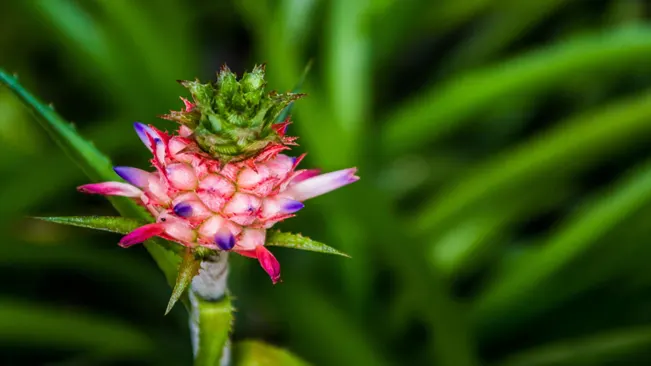
- As the bud opens, a cluster of flowers emerges. These individual flowers are small, vibrant, and typically blue, purple, or red. Each flower is capable of producing a seed, but in cultivated pineapples, seed formation is often minimal or absent.
Transformation into Fruit
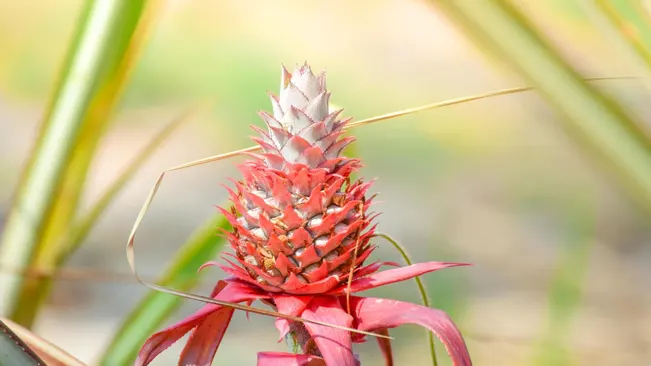
- What is truly unique about the pineapple is that the fruit is actually a result of the fusion of these individual flowers. As the flowers mature, their bases swell and merge together, forming what we recognize as a pineapple. This process is known as “syncarpous,” where multiple ovaries merge to form a single fruit.
Timing and Conditions
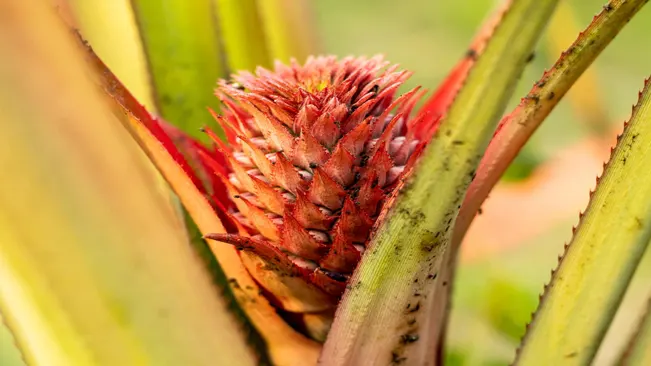
- The timing of flowering can be affected by environmental factors. Pineapples prefer a warm climate, and extreme temperatures or variations can delay flowering. Additionally, growers sometimes use ethylene-producing substances to encourage flowering in commercial cultivation.
After Flowering

- Once the flowers have bloomed and begun their transformation into fruit, it takes about another 5-6 months for the pineapple to fully mature. During this time, the fruit enlarges and changes color from green to the golden-yellow we associate with ripe pineapples.
Harvesting Your Pineapple
The fruit is ready to harvest when it becomes bigger, smells sweet, and changes from green to golden-yellow. Twist the pineapple off or cut it from the plant.
Understanding Pineapple Ripeness

- Color Change: A ripe pineapple will change color, moving from green to a golden-yellow hue. This change usually starts at the base of the fruit and progresses upwards.
- Sweet Aroma: A ripe pineapple emits a sweet, fragrant aroma. If you can smell the sweetness without even cutting the fruit, it’s a good sign that it’s ripe.
- Size and Firmness: A ripe pineapple will be firm to the touch, but not hard. Its size should be proportionate to the plant, and it should feel heavy for its size.
The Right Time to Harvest

- Pineapples do not continue to ripen significantly after they are harvested, unlike some other fruits. Therefore, it’s important to harvest them when they’re just right.
- The best time to harvest is when the pineapple has developed its golden-yellow color on at least one-third of its surface.
- The timing can vary; it’s usually about 5-6 months after the flower first appears and about 18-24 months after planting the crown.
Harvesting Technique

- Twisting Off: The traditional method of harvesting a pineapple is by twisting it off. Hold the fruit firmly and twist it until it detaches from the stalk. This method is gentle and reduces the risk of damaging the plant.
- Cutting: Alternatively, you can cut the pineapple off the plant. Use a sharp knife to cut the stalk about an inch above the fruit. Be careful not to damage the remaining plant, as it can produce more fruit.
After Harvest Care
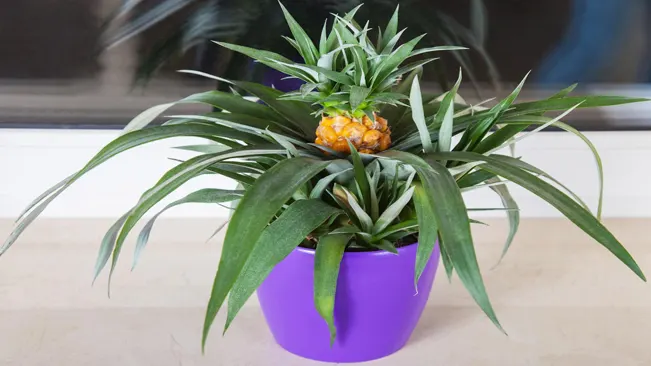
- After harvesting, the plant can continue to grow and may produce additional fruit. Smaller shoots, known as ‘suckers’ or ‘ratoons’, will grow from the base or along the stalk of the plant. These can be left to grow into new plants.
- You can also remove and plant these shoots separately to propagate new pineapple plants.
Enjoying Your Pineapple
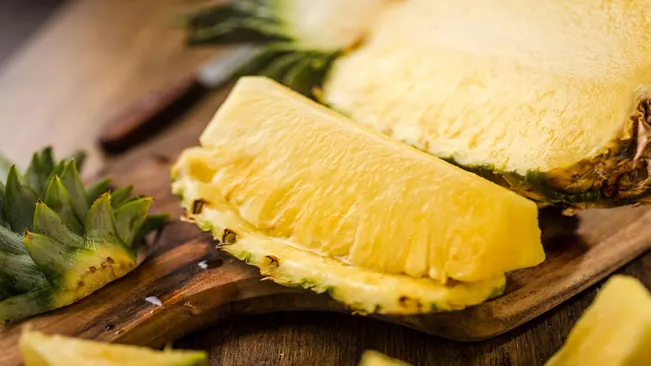
- Once harvested, the pineapple can be eaten immediately, or it can be stored at room temperature for a couple of days to further soften a bit.
- Refrigerating the pineapple can help to prolong its shelf life after it has reached your desired level of ripeness.
Conclusion
Growing pineapples can be a rewarding experience, yielding fresh, sweet fruits right from your garden or indoor space. With the right care, patience, and a bit of tropical sun, you can turn that leftover crown into a thriving pineapple plant. Enjoy the process and the delicious rewards of your labor!
FAQs (Frequently Asked Questions)
- Can I grow a pineapple from a store-bought pineapple?
Yes, you can grow a pineapple from the crown of a store-bought pineapple. Simply twist off the crown, remove the lower leaves, let it dry for a few days, and then root it in water or soil. - How long does it take to grow a pineapple?
Growing a pineapple can take about 18-24 months from planting the crown to harvesting the fruit. The exact time may vary depending on growing conditions. - Do pineapples need a lot of sun?
Yes, pineapples thrive in sunny environments. They require at least 6-8 hours of direct sunlight each day. - What is the best soil for growing pineapples?
Pineapples prefer well-draining, slightly acidic soil. A mix of potting soil, sand, and perlite or peat moss works well. - How often should I water my pineapple plant?
Water your pineapple plant so that the soil is moist but not waterlogged. Allow the top inch of soil to dry out between waterings. Pineapples are drought-tolerant and sensitive to overwatering. - Do I need to fertilize my pineapple plant?
Yes, feeding your pineapple plant with a balanced, water-soluble fertilizer monthly during the growing season is beneficial. Reduce feeding in the winter. - Can I grow a pineapple indoors?
Yes, pineapples can be grown indoors in a pot, provided they have enough sunlight and warm temperatures. A sunny windowsill or a grow light can be helpful. - How do I know when my pineapple is ready to harvest?
The pineapple is ready to harvest when it turns a golden-yellow color, has a sweet aroma, and feels firm. This typically happens 5-6 months after the flower appears. - Can a pineapple plant produce more than one fruit?
Typically, a pineapple plant produces one main fruit per plant. However, it can produce smaller fruits from side shoots or suckers after the main fruit is harvested. - How can I propagate a pineapple plant?
Pineapple plants can be propagated from the crown of the fruit, suckers, and slips. These can be planted in soil and grown into new pineapple plants.

Kristine Moore
Forestry AuthorI'm Kristine Moore, a seasoned garden landscaping professional with over 30 years of experience. My extensive career has been dedicated to transforming outdoor spaces into stunning, sustainable landscapes. With a deep understanding of horticulture, design principles, and environmental stewardship, I have become a respected figure in the field, known for creating harmonious, visually appealing, and eco-friendly gardens. My commitment to excellence and continuous learning in landscaping trends and techniques has solidified my reputation as an expert in garden design and implementation.











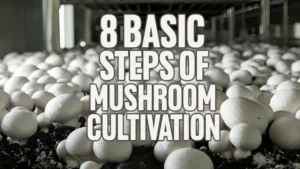

Leave your comment